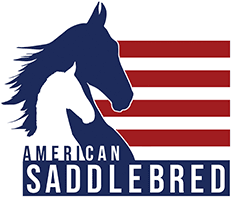
Breed History
The American Saddlebred has a long and proud history. The American Saddlebred became a recognized breed evolving from the Kentucky Saddler to the Saddle Horse in the 1800's. This breed was created through the refinement of prominent Thoroughbred and Trotting Horse foundation sires that crossed with Pacers, Hackneys, Morgan Horses and more to develop the breed officially organized by the American Saddle Horse Breeders Association in 1891.
From the battlefields of the American colonies to the bright lights of Madison Square Garden, the American Saddlebred has trotted to a tremendous legacy as the “Horse America Made.” The breed’s inherent presence, athleticism and grace inspired the start of American horse shows, America’s first breed registry organization, and helped cultivate the horse and human relationship in the United States of America.
On their way to defining the idea of the “Ultimate Show Horse” they competed with the US Army Equestrian Team at the Olympics through the 1950's, claimed some of the highest recorded rides in distance riding history and worked to develop the national park system in the American West.
If you are interested in learning more about the history of the Saddlebred, be sure to visit the American Saddlebred Museum while in Lexington.
1600s: The Beginnings
The history of the American Saddlebred began in the 1600’s. The Narragansett Pacer was a hardy, naturally gaited breed developed through selective breeding of Galloway and Hobbie Horses, and is often recognized as the first horse breed to be developed in the United States. This new breed of horse became an all-purpose riding horse, and was nicknamed the “American Horse” by the 1700’s. Paul Revere, on his famous “Midnight Ride” through the colonies, rode a Narragansett Pacer.
1700s: The American Horse
Thoroughbreds were imported to the Colonies in 1706. The “American Horse” was refined through the crossing of the Thoroughbreds with Narragansett Pacers. These crosses retained the easy gaits and stamina of Narragansett Pacers, with added size and strength from Thoroughbreds.
1800s: Saddle Horses
American Horses went west with the pioneers and, in Kentucky, horsemen continued to add Thoroughbred blood to their easy-gaited horses, developing a larger, more refined, all-purpose animal known as Kentucky Saddlers.
During the Civil War, Kentucky Saddlers were brave, agile, and athletic partners for their mounts. Many high-ranking officials rode Kentucky Saddlers. After the war, demand for Kentucky Saddlers as pleasure horses brought forth the beginning of a new chapter for the breed.
The first exhibition of Kentucky Saddlers was recorded near Lexington, Kentucky, in 1816. The sport continued to grow and the first national horse show occurred in 1856. The growing competitive atmosphere allowed for gifted horsemen to make a living at training show horses.
In 1891, the American Saddlebred Horse Association, originally known as the National Saddle Horse Breeders Association, was founded in Louisville, Kentucky and was the first organization for an American breed of horse.
20th Century: The American Saddlebred
In 1917 the Kentucky State Fair offered the first $10,000 five-gaited stake and claimed to be the World’s Championship. The American Horse Shows Association was founded the same year, and through the 1920s, horse shows continued to evolve, with format and rules becoming more standardized.
Shows varied across the nation, from the high society affairs of New York and Los Angeles, to the great state fairs of the South and Midwest, to the county fairs which were more athletic contests than society functions.
Excitement for horse shows was revived after World War II with stars such as CHOak Hill Chief and six-time World's Grand Champion CHWing Commander. Hundreds of horse trainers practiced their trade, particularly in rural areas.
In the 1950s, new stars emerged on the scene, including the fine harness star CHThe Lemon Drop Kid who once graced the cover of Sports Illustrated.
The American Saddlebred Pleasure Horse Association was formed in 1957, giving stature to the English Pleasure classes which had already been a mainstay on the show circuit. Today, the pleasure divisions rival all others in numbers.
The Saddlebred world flourished in the 1970s and 1980s, and the over-the-top 1980s saw the legendary rivalry of World's Grand Champions CHSky Watch and CHImperator in five gaited, and the five-year reign of CHSultan's Starina in three-gaited.
In the 1990s, focus shifted to riding programs in order to lay the groundwork for new generations of Saddlebred enthusiasts. Youth have since become a large part of the Saddlebred community, with the rise of Academy, ASHBA Youth Clubs and opportunities such as the World Cup and Young Rider programs.
Today, the American Saddlebred is a versatile horse that has found success not only in saddle seat disciplines, but in dressage, eventing, distance riding, foxhunting, hunter-jumper, polo, and western disciplines.
